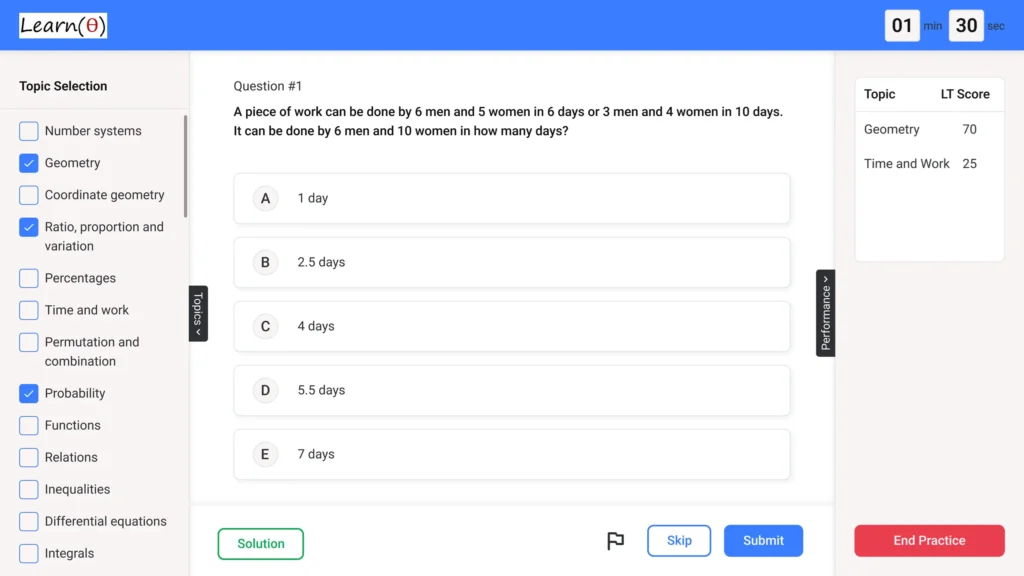Aptitude Syllabus for Placement Tests
We’ve outlined the key topics commonly tested in on-campus and off-campus placements for IT and non-IT companies. This list covers 80–90% of the questions.
PDF copy of Aptitude Syllabus for Placements!
Get the complete list of topics for placement aptitude tests and start your preparation the right way!
Section 1: Quantitative Aptitude
1. Percentages
- Focuses on calculating increases, decreases, and comparing values as percentages.
- Example Question: If a product’s price increases by 20% and then decreases by 10%, what is the final price relative to the original?
2. Ratio & Proportion
- Covers comparisons and relationships between two quantities.
- Example Question: If the ratio of A to B is 2:3 and B to C is 4:5, what is the ratio of A to C?
3. Profit, Loss, and Partnership
- Tests concepts of business transactions and sharing profits/losses.
- Example Question: A trader buys an item for ₹200 and sells it for ₹240. Find the profit percentage.
4. Averages, Mixtures, and Alligations
- Questions involve finding averages or mixtures of quantities.
- Example Question: A shopkeeper mixes 10 kg of rice costing ₹40/kg with 5 kg costing ₹60/kg. What is the average price per kg?
5. Time and Work
- Problems on work efficiency and time required to complete tasks.
- Example Question: If A can complete a task in 10 days and B in 15 days, how many days will they take together?
6. Time, Speed, and Distance
- Includes concepts like relative speed, trains, and boats.
- Example Question: A train travels 300 km in 3 hours. What is its speed in km/hr?
7. Simple and Compound Interest
- Focuses on financial mathematics.
- Example Question: If ₹10,000 is invested at 10% annual interest compounded yearly, what will be the amount after 2 years?
8. Numbers
- Includes divisibility, remainders, and number theory.
- Example Question: Find the remainder when 12345 is divided by 9.
9. Algebra
- Covers equations, inequalities, and simplifications.
- Example Question: Solve for x if: 2x−3 = x/5
10. Permutation & Combination
- Questions on arranging and selecting items.
- Example Question: How many ways can 4 people sit in a row?
11. Probability
- Deals with likelihood and events.
- Example Question: What is the probability of getting a sum of 7 when rolling two dice?

Crack Placement Tests – Faster & Smarter!
Adaptive Practice | Real Time Insights | Resume your Progress
Section 2: Logical Reasoning
1. AlphaNumeric Series
- Identifying patterns in sequences of letters and numbers.
- Example Question: Complete the series: A1, B2, C3, D4, ?
2. Blood Relations
- Questions based on family connections.
- Example Question: Pointing to a photograph, A says, “He is the son of my only sister.” How is the person related to A?
3. Coding-Decoding
- Interpreting coded messages.
- Example Question: If “BAT” is coded as “ABU”, how is “CAT” coded?
4. Data Sufficiency
- Deciding whether the given information is sufficient to answer a question.
- Example Question: Is x >10? given that (1) x > 9 (2) x < 11
5. Direction Sense
- Tests ability to trace movements and determine direction.
- Example Question: A person walks 10 m north, then 10 m east. What is the shortest distance to the starting point?
6. Statement & Conclusion
- Deriving logical conclusions from statements.
- Example Question: Statement: “All cats are animals.” Conclusion: “All animals are cats.” True or False?
7. Arrangements
- Questions on seating or linear arrangements.
- Example Question: If A sits to the right of B and C sits to the left of B, who is in the middle?
8. Calendar and Clocks
- Questions on dates and time-related problems.
- Example Question: What day of the week was January 1, 2020?
Improve Aptitude with LearnTheta’s AI Practice
Adaptive Practice | Real Time Insights | Resume your Progress

Section 3: Verbal Ability
1. Synonyms and Antonyms
- Testing vocabulary.
- Example Question: What is the synonym of “elated”?
2. Fill in the Blanks (Grammar-Based)
- Focuses on grammar rules.
- Example Question: She ___ to the market yesterday. (went/goes)
3. Error Finding
- Identifying grammatical errors in sentences.
- Example Question: Find the error: “She don’t like apples.”
4. Sentence Correction
- Requires improving sentence structure.
- Example Question: Correct the sentence: “He go to school daily.”
5. Reading Comprehension
- Tests understanding of written passages.
- Example Question: Based on the passage, what is the main theme?
6. Verbal Analogies
- Involves finding relationships between words.
- Example Question: Pen: Write :: Knife: ?
How difficult are Placement Aptitude Tests?
This is a common question among students, and the answer is—it depends. Placement tests vary from company to company, but generally speaking, they are much easier than exams like CAT. While success rates in placement tests range from 10-50% (depending on the company), CAT has a success rate of only around 10% (with a 90 percentile+ required for a good college). So, placement tests are relatively easier to crack, but the key is preparation—only those who prepare thoroughly make it through.
Some companies, like TCS, ZS, and MuSigma, typically set higher-difficulty tests, while others like Accenture, Capgemini, Cognizant, and Infosys tend to have easier tests. We’ve used examples from mass recruiters to give you a sense of the difficulty level, but remember, there’s always variation in syllabus and difficulty across companies. The key takeaway is that with proper preparation, you’ll be ready for any surprises that come your way. You can also check company wise syllabus.
Once you’ve gone through the syllabus, be sure to go through topic-wise concepts, topic-wise aptitude questions, and preparation tips. After that, sign up with LearnTheta to practice and improve your aptitude skills for placements.
Crack Exams Faster and Smarter – with LearnTheta’s AI-Practice!

✅ All Topics at One Place

🤖 Adaptive Question Practice

📊 Progress and Insights
Super